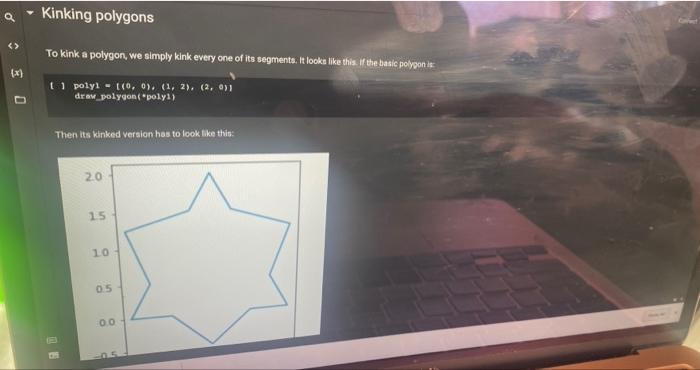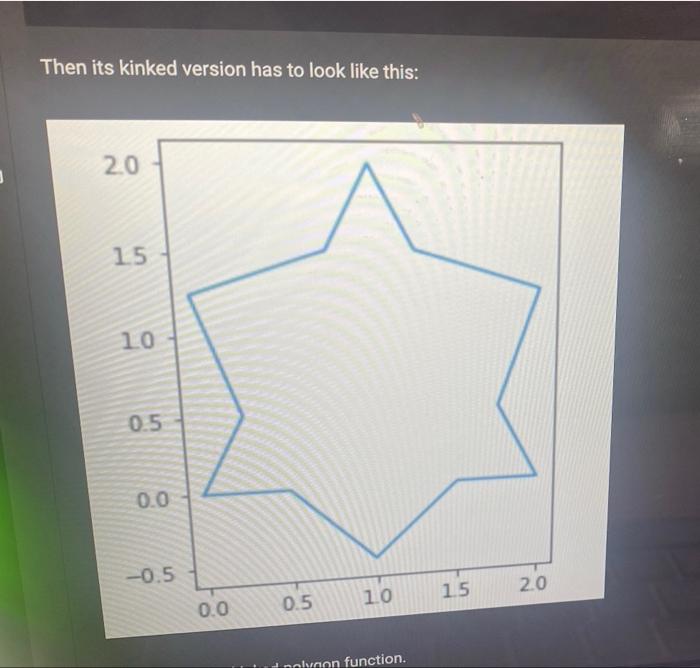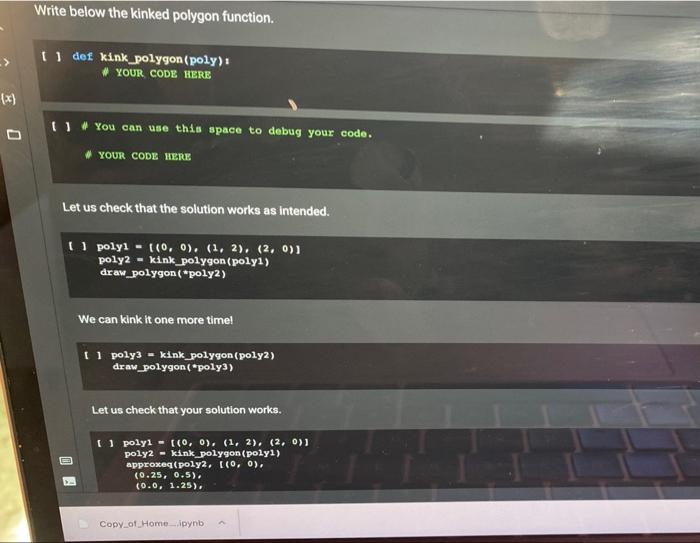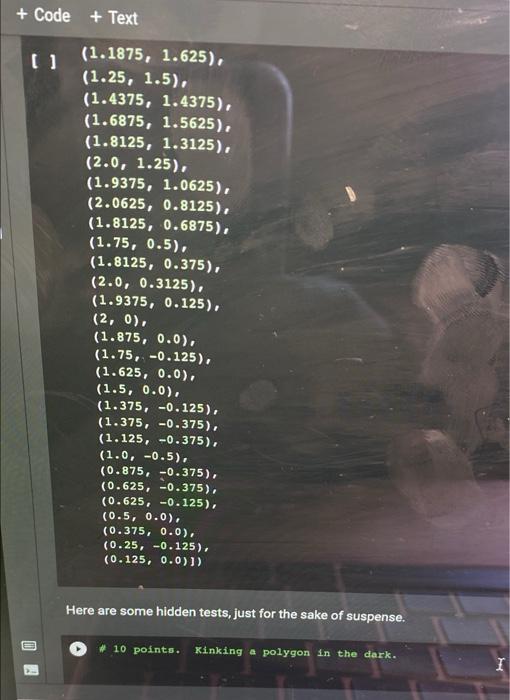Answered step by step
Verified Expert Solution
Question
1 Approved Answer
please use python and # to explain what you are doing. please be aware there are hidden test all these photos are apart of the
please use python and # to explain what you are doing. please be aware there are hidden test
o Kinking polygons x) To kink a polygon, we simply klink every one of its segments. It looks like this. If the basic polypon is polyl - to... (1, 2), (2. oyi draw_polygon( poly) o Then its kinked version has to look like this: 20 15 10 05 00 Then its kinked version has to look like this: 20 15 10 0.5 0.0 -0.5 1.5 2.0 10 0.5 0.0 on function. Write below the kinked polygon function. U def kink_polygon (poly) YOUR CODE HERE (x) 0 0 0 You can use this space to debug your code. YOUR CODE HERE Let us check that the solution works as intended. u polyi - f(0, 0), (1, 2), (2, 0) poly2 - kink_polygon (polyi) draw_polygon(*poly) We can kink it one more time! poly3 - kink_polygon (poly) draw_polygon( *poly3) Let us check that your solution works. # D A polyl-((0, 0), (1, 2), (2, 0)) poly2 - kink polygon (polyi) approxeq(poly2. f(0, 0). (0.25, 0.5). (0.0, 1.25). Copy of Home_ipynb Let us check that your solution works. U polyi = [(0, 0), (1, 2), (2, 0)) poly2 = kink_polygon (polyl) approxeg(poly2, [(0, 0), (0.25, 0.5), (0.0, 1.25), (0.75, 1.5), (1, 2), (1.25, 1.5), (2.0, 1.25), (1.75, 0.5), (2, 0), (1.5, 0.0), (1.0, -0.5), (0.5, 0.01) poly3 kink_polygon (poly2) approxeg (poly3, [(0, 0), (0.0625, 0.125), (0.0, 0.3125), (0.1875, 0.375), (0.25, 0.5), (0.1875, 0.6875), (-0.0625, 0.8125), (0.0625, 1.0625), (0.0, 1.25), (0.1875, 1.3125), (0.3125, 1.5625), (0.5625, 1.4375), (0.75, 1.5), (0.8125, 1.625), (0.75, 1.8125), (0.9375, 1.875), (1, 2), (1.0625, 1.875), (1.25, 1.8125), (1.1875, 1.625), + Code + Text (1.1875, 1.625), (1.25, 1.5), (1.4375, 1.4375), (1.6875, 1.5625), (1.8125, 1.3125), (2.0, 1.25), (1.9375, 1.0625), (2.0625, 0.8125), (1.8125, 0.6875), (1.75, 0.5), (1.8125, 0.375), (2.0, 0.3125), (1.9375, 0.125), (2, 0), (1.875, 0.0), (1.75, -0.125), (1.625, 0.0), (1.5, 0.0), (1.375, -0.125), (1.375, -0.375), (1.125, -0.375), (1.0, -0.5), (0.875, -0.375), (0.625, -0.375), (0.625, -0.125), (0.5, 0.0), (0.375, 0.0), (0.25, -0.125). (0.125, 0.0))) Here are some hidden tests, just for the sake of suspense. 10 points. Kinking a polygon in the dark all these photos are apart of the same question 









Step by Step Solution
There are 3 Steps involved in it
Step: 1

Get Instant Access to Expert-Tailored Solutions
See step-by-step solutions with expert insights and AI powered tools for academic success
Step: 2

Step: 3

Ace Your Homework with AI
Get the answers you need in no time with our AI-driven, step-by-step assistance
Get Started


